Have you ever wondered if all Pitbull puppies start their journey with those striking blue eyes? You’re not alone! As someone deeply familiar with Pitbulls throughout my life, I’m here to answer this intriguing question.
In this article, we’ll discover the fascinating world of Pitbull puppy eye colors. We’ll learn about the genes that make their eyes different colors, clear up some common misunderstandings, and see how these colors might change as they grow. So, if you’re curious about Pitbull pups and their eye-catching peepers, let’s dive in and uncover the fascinating truth together.
| Origin | United States |
| Coat Colors | Blue, White, Black, Red, Fawn, Brindle, and more |
| Hypoallergenic Breed | No |
| Living Environment | Well-suited for homes with space to move around |
| Training Ease | Moderate |
| Energy Level | High |
| Grooming Needs | Low to Moderate |
| Barking Tendency | Moderate |
| Snoring Tendency | Moderate |
Are all pitbull puppies born with blue eyes?
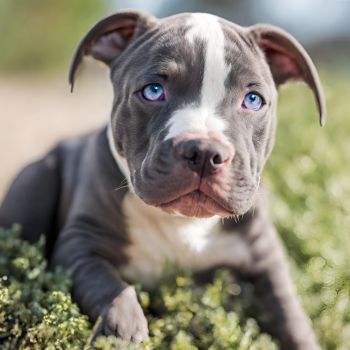
No, not all Pitbull puppies are born with blue eyes.
Pitbull puppies can have a variety of eye colors, including blue, brown, green, and amber.
Eye color in Pitbulls is determined by specific genes that control iris pigmentation.
The presence or absence of these genes leads to the different eye colors observed in Pitbull puppies.
Pitbull Puppy Eye Colors:
Pitbull puppies are known for their captivating appearance, and one intriguing aspect is their eye colors.
Pitbull puppies don’t all have the same eye color. Some have blue eyes, while others have brown, green, or even amber eyes.
This diversity makes each Pitbull puppy unique.
Genetics of Eye Color in Pitbulls:
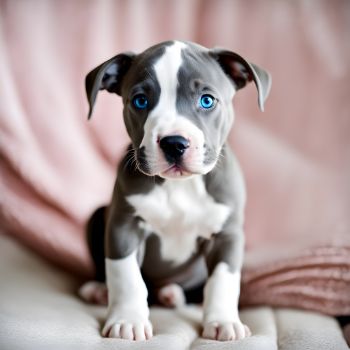
Genes mainly determine the color of a Pitbull puppy’s eyes. Imagine genes as tiny instruction books inside a Pitbull’s body.
These instructions specify everything about them, including their eye color.
So, if the gene instructions say “blue eyes,” that’s what the Pitbull will have. If they say something else, like “brown eyes,” that’s what they get.
1. The Merle Gene:
The Merle gene is one of the key genetic factors influencing eye color in Pitbulls. This gene can lead to various coat patterns and colors, including blue eyes.
When a Pitbull inherits one copy of the Merle gene from either parent, it can result in a Merle coat pattern and potentially blue eyes.
However, it’s important to note that excessive merle breeding can lead to health issues, including vision problems.
2. The ALX4 Gene:
Another gene known as ALX4 also plays a role in eye color in dogs.
Variations in this gene can affect the pigmentation of the eyes, leading to blue or brown eyes.
It interacts with other genes to determine the final eye color outcome.
3. Levels of Melanin:
The amount of melanin, a pigment responsible for color in the eyes, is a critical factor in determining eye color in Pitbulls. Blue eyes typically have lower melanin levels, while brown eyes have higher melanin content.
4. Albinism:
Albinism is a genetic condition that can result in very pale blue or pinkish eyes in dogs. Pitbulls with albinism often have a predominantly white coat and are more prone to skin and eye issues due to their lack of melanin.
Related Study on Blue Eye Color in Dogs:
In a study conducted by multiple American universities and published on the National Library of Medicine website, researchers aimed to find the genetic basis of blue eye color in dogs. Through a comprehensive genome-wide association study (GWAS) involving over 3,000 dogs, they made significant discoveries related to blue eyes in canines.
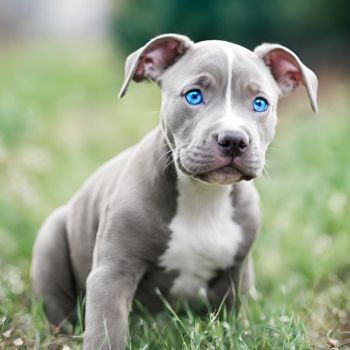
One key finding confirmed the importance of the “merle” gene on chromosome 10 (PMEL17), a gene previously recognized for influencing blue eye color in dogs.
Moreover, the study introduced a novel genetic locus on chromosome 18 (CFA18), positioned at 44,924,848, strongly associated with blue eyes in dogs. This newfound locus shed light on the genetic complexity of blue eye color in canines.
Importantly, the study highlighted that markers near MITF (Microphthalmia-Associated Transcription Factor) did not exhibit significant associations with blue eyes, emphasizing that piebald coat color, known to contribute to blue eyes, has a limited influence on this trait.
These findings provide valuable insights into the genetics of blue eye color in dogs and open the door to further research on this captivating and complex trait.
Blue Eyes in Pitbull Puppies:
Blue eyes in Pitbull puppies are a captivating and distinct feature that often draws attention. This eye color variation results from specific genetic factors and is more commonly associated with certain coat patterns and colors in these dogs.
Are blue eyes rare in pitbull puppies?
Yes, Blue eyes in Pitbull puppies are relatively rare. While brown is Pitbulls’ most common eye color, some puppies have blue eyes. However, the occurrence of blue eyes in Pitbull puppies is uncommon. Therefore, if you come across a Pitbull puppy with blue eyes, it’s a unique and unusual trait that makes them stand out.
Out of all, around 8% of Pitbull puppies are born with blue eyes.
How Long Can Pitbull Puppy Eyes Be Blue?
Pitbull puppy eyes can be blue for several weeks to 4 months after birth. When puppies are born, their eyes are closed in the initial stages.
As their eyes gradually open around 10 to 14 days old, you might notice a hazy blue color. This initial blueness is due to a lack of pigmentation in their irises. Over time, the blue color intensifies and becomes more distinct as the puppies develop.
However, the exact duration of blue eyes can vary among individual puppies. Some may retain their blue eyes a bit longer than others before undergoing the natural transition to their permanent eye color.
Will The Blue Eyes Change?
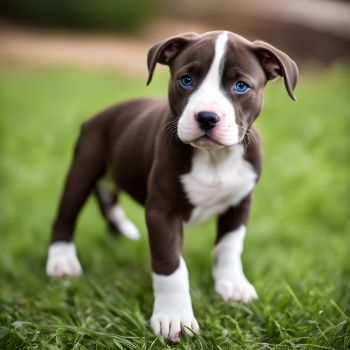
Yes, blue eyes in Pitbull puppies can change as they mature.
It’s a natural part of their development. Many little Pitbull puppies are born with blue eyes because they have the “merle gene,” which gives them that pretty blue color.
However, as they age, their eye color can undergo a transition.
For those who adore their Pitbull puppy’s blue eyes, it’s essential to be patient and observe any changes.
The transition, if it happens, is usually gradual. When a Pitbull puppy ages a few months, you’ll know whether their blue eyes are here to stay or will transform into another shade.
Factors Affecting Eye Color Changes:
Pitbull puppy eye colors can be a source of fascination, but did you know these colors may change over time?
It can occur because of a combination of environmental and genetic factors.
At birth, most Pitbull puppies have blue eyes. But here’s the exciting part: as puppies grow, their eye colors can change based on their unique genetic makeup.
• Environmental Factors:
Environmental factors can also influence eye color changes. Exposure to sunlight, for example, can impact eye color.
Pitbull puppies‘ eyes are sensitive, and excessive sunlight can darken their eye color over time. It’s like how our skin tans in the sun – their eyes can become darker due to sun exposure.
• Puppy Growth and Eye Development:
As Pitbull puppies mature, their eye colors can naturally evolve. This transformation typically happens during the first few months of life.
Sometimes, the blue shade they’re born with might change to a hazel, green, brown, or even a combination of these colors. This transition is part of their normal development.
Overall, What to Expect:
If you’re raising a Pitbull puppy, it’s important to remember that their eye color may change as they grow, which is entirely normal.
Genetics and the environment can both play their part. So, don’t be surprised if those bright blue eyes you fell in love with become a different shade.
Common Misconceptions:
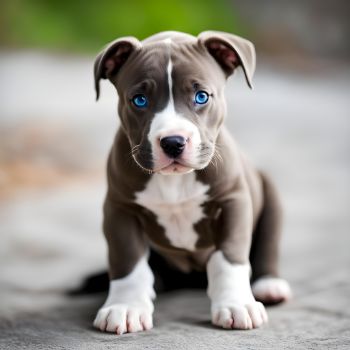
Pitbull puppy eye colors are a topic of curiosity and sometimes misunderstanding.
1: All Pitbull Puppies Have Blue Eyes
It’s a widespread belief that all Pitbull puppies are born with and keep blue eyes.
However, while many Pitbull puppies are born with blue eyes due to the merle gene, not all will keep this color as they grow.
Their eye colors can change, and it’s normal for them to transition to other shades.
2: Blue-Eyed Pitbulls Are Always Deaf
It is not necessarily true. While some Pitbulls with the Merle gene may have a higher risk of deafness, especially if both parents have the Merle gene, it doesn’t mean all blue-eyed Pitbulls are deaf. Each dog’s hearing should be evaluated individually.
3: Eye Color Change is Unhealthy
Some people worry that a change in eye color indicates health problems.
In most cases, it doesn’t. Eye color changes in Pitbull puppies are typically part of their normal development and are influenced by genetics and the environment.
4: You Can Predict Adult Eye Color from Puppy Eyes.
Predicting an adult Pitbull’s eye color based on their puppy eyes is tricky. As puppies grow, their eye colors can change. Even if they start with blue eyes, they might transition to green, brown, or hazel as they mature.
Are Blue Eyes Not Acceptable?
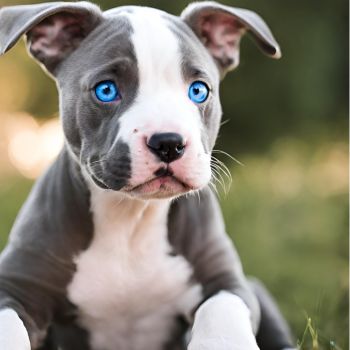
Blue eyes in Pitbulls can be captivating, but whether they are considered acceptable according to breed standards varies depending on the specific kennel club or breed organization.
• Variability in Standards:
Different kennel clubs and breed organizations set standards for Pitbulls, but these standards vary.
Some breed standards explicitly mention that blue eyes are a disqualification, meaning Pitbulls with blue eyes would not meet the criteria for that particular standard.
• AKC (American Kennel Club):
The American Kennel Club (AKC), one of the most prominent dog breed organizations, follows the United Kennel Club (UKC) standard for the American Pit Bull Terrier.
According to the UKC standard, blue eyes are considered a cosmetic fault but do not disqualify a dog from being registered or participating in events. However, blue-eyed Pitbulls may receive lower show ratings in conformation competitions.
• UKC (United Kennel Club):
The UKC standard, as mentioned, views blue eyes as a cosmetic fault but does not disqualify Pitbulls with blue eyes. Dogs with this characteristic can still participate in various events and activities.
Why Blue-Eyed Pitbulls Need Special Care?
Blue-eyed Pitbulls, with their striking eye color, require special care due to several important factors.
• Eye Sensitivity:
Blue eyes in Pitbulls can be more sensitive to bright sunlight, potentially leading to discomfort or eye strain. Special care involves protecting their eyes from excessive sun exposure, such as using doggy sunglasses or providing shade during sunny days.
• Skin Protection:
Light-colored eyes often accompany lighter skin pigmentation, making blue-eyed Pitbulls more susceptible to sunburn. Applying pet-safe sunscreen to their skin, particularly on the nose and around the eyes, is essential to prevent sunburn-related issues.
• Vision Health:
Monitoring the eye health of blue-eyed Pitbulls is crucial. Going to the vet for check-ups is vital because they can find and fix eye problems early to see well.
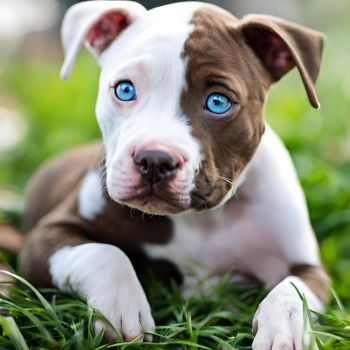
Blue-Eyed Pitbull Price:
Blue-eyed Pitbull puppies can range from approximately $800 to $3,000, depending on the breeder’s reputation, bloodline, coat color, location, and overall health.
Reputable breeders who prioritize responsible breeding practices and the well-being of their dogs may charge higher prices.
At the same time, unique coat patterns or colors and specific eye colors can also influence the cost.
Breeding Blue-Eyed Pit Bulls:
Creating Pitbull puppies with blue eyes can be fascinating, but there are essential things to consider.
• Picking the Right Parents:
Choose the right parents to have blue-eyed Pitbull puppies. At least one of the parents should have a particular gene called “merle” that can give the puppies blue eyes. But be careful; if both parents have this gene, it can cause problems like deafness in their puppies. So, it’s essential to make wise choices.
• Choosing Carefully:
When you want blue-eyed Pitbulls, carefully pick dogs with the right genes. It’s not always easy to predict if a puppy has blue eyes because genes can be tricky.
• Checking Their Health:
You should ensure the dogs are healthy before breeding. Regular check-ups and tests can help find any health issues. This way, you can avoid passing problems to the puppies.
• Being Ethical:
It’s essential to be a responsible breeder. Don’t just focus on making blue-eyed Pitbulls; think about their health and behavior. It’s not just about looks.
• Follow the Rules:
Different clubs and groups have rules about Pitbulls. Some accept blue eyes, and others don’t. Make sure you know the rules and follow them when breeding.
Why is the Trait of Blue Eyes Often Viewed Negatively in Pitbulls?
Blue eyes in Pitbulls are generally considered a unique and visually striking trait rather than a negative one. While the breed standard for American Pit Bull Terriers may favor brown eyes, having blue eyes does not inherently affect a pit bull’s health, temperament, or behavior.
Blue-eyed Pitbulls are just as loving, loyal, and capable of being beautiful pets as those with brown eyes. It’s essential to recognize that eye color is merely a cosmetic variation and should not be a basis for negative judgments.
Ultimately, the perceived negativity surrounding blue eyes in pit bulls is mainly unwarranted, and these dogs should be appreciated for their personalities and qualities rather than their eye color.
Can Pitbulls Have One Blue Eye?
Yes, Pitbulls can indeed have one blue eye, and this occurrence is known as heterochromia.
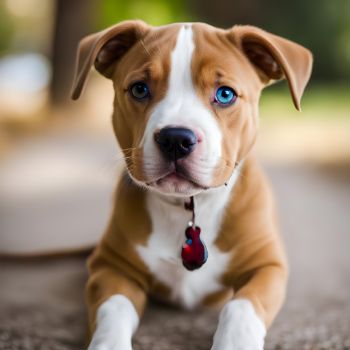
Heterochromia is a fascinating and relatively rare phenomenon where a pitbull has two eyes of different colors, and one of these colors can be blue.
The occurrence of heterochromia in Pitbulls is primarily due to genetics. It results from the interplay of various genes that control eye color.
Sometimes, a genetic mutation or variation can lead to one eye appearing blue while the other remains brown or another color.
Heterochromia does not have any adverse effects on a pit bull. Dogs with one blue eye are just as healthy and loving as those with matching eye colors. It’s a purely cosmetic variation and should be appreciated as one of the many charming aspects of these dogs.
Should You Adopt a Pitbull with Blue Eyes?
Adopting a blue-eyed Pitbull can be a fulfilling choice, but it’s essential to consider it thoughtfully.
- Prioritize the dog’s temperament, health, and how well they fit into your lifestyle.
- Dedicate time and commitment to their training and socialization needs.
- Ensure your living environment is suitable for a Pitbull’s exercise requirements.
- Remember to know the rules in your area about owning Pitbulls.
- Consider adopting a Pitbull from a trusted rescue group or animal shelter to give them a caring and good home, regardless of their eye color.
Pitbull Blue Eye Color Characteristics:
| Eye Color | Striking blue, captivating, and unique |
| Genetic Influence | Presence of the merle gene (genetic factor) |
| Variability | Not all Pitbull puppies inherit the merle gene |
| Association with Coat Color | Merle gene affects coat and eye color |
| Color Change Over Time | Blue eyes may become more pronounced or shift in hue |
| Breed Standards | Not a disqualification, but not typical in breed standards |
Are Blue-Eyed Pitbulls More Aggressive?
No, blue-eyed Pitbulls are not inherently more aggressive than Pitbulls with different eye colors. A dog’s behavior can be complicated, and how they act depends on many things, like their family, friends, and upbringing. Eye color, whether blue or brown, does not determine a dog’s aggression level.
Statistics and studies have shown no significant correlation between a pit bull’s eye color and aggression. The perceived aggressiveness of pit bulls is often based on misconceptions and stereotypes not grounded in scientific evidence.
Does Blue-Eyed Pitbull See Differently?
Blue-eyed Pitbulls do not see differently from Pitbulls with brown eyes or other eye colors.
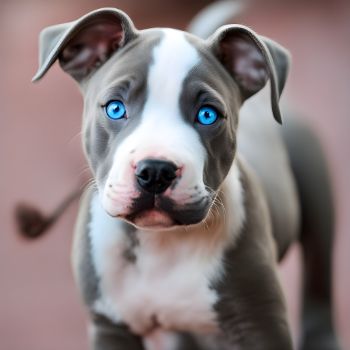
Regarding their vision, there is no significant difference related to eye color.
Dogs, including Pitbulls, have similar visual capabilities regardless of whether their eyes are blue, brown, or another color.
The color of a dog’s eyes is primarily determined by pigmentation in the iris and does not affect the functioning of their retinas or the structure of their eyes.
Therefore, blue-eyed Pitbulls have the same visual abilities and limitations as any other Pitbull.
Their vision is well-suited to their natural behaviors, such as hunting and navigating their surroundings, regardless of their eye color.
FAQs
Is Blue-Eyed Pitbull Puppies a Health Concern?
Having blue eyes in Pitbull puppies is generally not a health concern. Blue eyes themselves do not indicate any specific health issues.
However, it’s essential to remember that some health problems can be associated with the merle gene, especially when both parents carry it. These issues may include hearing problems or vision impairments.
Are Blue Eyes in Pitbulls associated with specific coat colors or patterns?
Yes, blue eyes in Pitbulls are often linked to specific coat patterns and colors influenced by genetics. The Merle gene and other specific coat-related genes can increase the likelihood of blue eyes in Pitbulls. However, not all dogs with these coat patterns will have blue eyes.
Are blue-eyed Pitbull puppies more valuable or desirable?
Some people consider Blue-eyed Pitbull puppies more desirable due to their unique appearance. Still, their value should be based on factors like health, temperament, and lineage rather than eye color alone.
Do all blue-eyed Pitbull puppies have health issues?
No, not all blue-eyed Pitbull puppies have health issues. Blue eyes result from genetics and don’t necessarily indicate health problems. However, responsible breeders should prioritize the overall health of their puppies.
Are blue-eyed Pitbull puppies more prone to blindness or eye conditions?
Blue-eyed Pitbull puppies are not inherently more prone to blindness or eye conditions compared to Pitbull puppies with other eye colors. Regularly taking your dog to the vet is essential to ensure their eyes are healthy.
Are there different shades of blue in Pitbull puppy eyes?
Yes, there can be variations in the shade of blue in Pitbull puppy eyes. Some may have pale blue eyes, while others may have a more intense blue color.
How can I care for the eyes of my blue-eyed Pitbull puppy?
To care for your blue-eyed Pitbull puppy’s eyes, keep them clean and free from discharge. If you notice any redness, irritation, or changes in eye color, consult a veterinarian for guidance.
Are blue-eyed Pitbull puppies good family pets?
Blue-eyed Pitbull puppies can make excellent family pets when properly socialized and trained. Their temperament and behavior depend more on upbringing and genetics than eye color.
Conclusion:
To sum it up, not every Pitbull puppy is born with blue eyes. Some do have these captivating blue peepers, but many others have different eye colors. The reason for this difference is usually linked to genes and how they work.
Remember, a Pitbull puppy’s eye color might also change as they grow up, and that’s okay!
So, whether your Pitbull puppy has blue eyes, what truly matters is the love and care you give them. Each one is unique, and that’s what makes them so wonderful.

